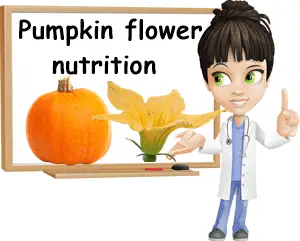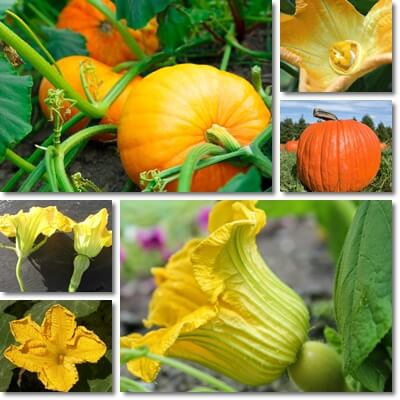Pumpkin flowers are a popular choice in ethnic cuisines especially. Typically, only the male pumpkin flowers from pumpkin plants are eaten, whilst the female flowers are left to develop into fruit. Regardless, both male and female pumpkin flowers are perfectly edible and a source of nutrition. Very low in calories and sodium, and a source of potassium and magnesium, pumpkin flower nutrition benefits cardiovascular health by helping lower high blood pressure numbers.
Source of vitamin C, the raw pumpkin blossoms hold benefits for teeth and gum health and the immune system. With good amounts of folate and a varied B vitamin profile, they are a good anti-anemia and pregnancy food.
What are pumpkin flowers?
Also called pumpkin blossoms, pumpkin flowers are the flowers of pumpkin plants. They appear after the plant develops, before the fruit. There are two types: male and female pumpkin flowers. Vs male pumpkin flowers which fall off following pollination, unless picked for consumption, female ones stay on the plant and turn into fruit. Depending on their uses in the kitchen and regional culinary lingo, pumpkin flowers can be considered either culinary fruits or, more commonly, culinary vegetables.

What do pumpkin flowers look like?
Pumpkin flowers are star-shaped, with 5 pointy triangle-like petals that are slightly crumpled at the edges. Each flower has a cup-shaped formation at the base and several thin, needle-like green sepals. What color are pumpkin flowers? Pumpkin flowers are usually yellow: the petals are a deep golden yellow color on top and a lighter yellow underneath, with visible greenish veins going upwards towards the petal margins.
Other squash or gourd species, some of which may be called ‘pumpkins’ depending on language and local culinary idiom, can also have yellow-colored flowers that look exactly like pumpkin flowers, making it difficult to tell the difference between pumpkin and other squash or gourd species just based on flower appearance.
Pumpkin flowers: male vs female
As stated above, there are two types of pumpkin flowers: male and female. While they may look exactly the same at first glance, there are some differences you can look for that can help you tell the male and female flowers apart. For one, male pumpkin flowers are attached to a longer, thinner stem, vs female pumpkin flowers which are attached to a visibly shorter and thicker stem. Male flowers typically form 1-2 weeks before the female ones, but that may not help much when it comes to choosing which to pick to eat because, at one point, both will be on the plant. Inside the flower, at its center, male blossoms have a golden or orange rod-like structure known as a stamen (a filament with an anther on top full of pollen), whereas female blossoms have a ball-like structure made of up several lobes (rounded projections).
Probably the most important difference, and the easiest to notice, is how the area right below the flower looks like: male pumpkin flowers are attached directly to a stem, vs female flowers which have a tiny, round swelling at the base, between the flower and the stem. That swelling is actually a baby pumpkin which will continue to grow until it reaches an almost gargantuan size. Of course, this difference is visible only after pollination, so you may want to wait a while before picking your pumpkin flowers.

Are all pumpkin flowers edible?
All pumpkin flowers from pumpkin plants are edible, whether male or female, as well as pumpkin leaves, shoots, seeds and rind. While you can eat both, it’s best to pick only male pumpkin blossoms (after pollination, of course) and leave the female blossoms on the plant to produce fruit. After all, you get more food from a mature pumpkin than one flower. The flowers from other edible squash or gourd species are also perfectly edible too. Pumpkin flowers are edible raw and cooked, but most people prefer to cook them to add to their flavor profile.
What do pumpkin flowers taste like?
Raw pumpkin flowers have a soft, velvety texture thanks to all the tiny hairs on the petals, and pleasant, light earthy-green flavors and a faint sweet aftertaste. Overall, they are quite delicate-tasting. Cooking adds to their flavor profile, but should be light considering the flowers are fragile. Depending on the recipe, the flowers will absorb the flavors of other ingredients they are cooked with. Here are some of the most popular pumpkin flower recipes:
- Fritters: whole pumpkin flowers dipped in batter and deep-fried.
- Donuts: the blossoms are added to a basic doughnut dough (milk, eggs, flour, yeast), portioned and rolled into balls, then deep-fried.
- Cream soup made from butternut squash/zucchini, pumpkin flowers, pepper, onion, butter, seasoned with salt, pepper, tarragon/oregano and thickened with sour cream, with chicken soup as a base.
- Stuffed blossoms. Whole pumpkin flowers can be stuffed with various fillings and cooked:
– spicy cheese and basil
– tomatoes, basil, mozzarella
– banana peppers, bacon or prosciutto crudo and cheese
– cream cheese and dill, dipped in batter
– leafy greens such as spinach and goat cheese
– shrimp, prawn, crab meat or lobster
Pumpkin flowers nutrition
Pumpkin flowers are modestly nutritious, low in calories and carbohydrates, cholesterol-free and almost fat-free. The blossoms are a modest source of sugars and relatively low in fiber and almost sodium-free. Pumpkin flowers stand out as a good source of folate (vitamin B9) and pro-vitamin A antioxidant carotenoids. Otherwise, their nutrition is unexceptional: varied, but low B vitamin content and modest content of calcium, iron, magnesium, phosphorus, potassium, vitamin C, vitamins B1, B2 and B3 and protein. Pumpkin flower nutritional status notes trace amounts of selenium, sodium, copper, zinc and vitamin E. The blossoms have been found to have no vitamin B12, no vitamin D and no vitamin K.
- Pumpkin flowers nutrition facts per 100 g (boiled, drained blossoms vs raw):
- Energy value: 15 kilocalories/kcal vs 15 kcal
- Carbohydrates: 3.3 g
- Sugars: 2.4 g
- Dietary fiber: 0.9 g
- Protein: 1.09 g -1.03 g
- Fat: 0.08 g – 0.07 g
- Cholesterol: 0 g
- Vitamin A: 87 micrograms/mcg equivalent of retinol (pre-formed vitamin A) from antioxidant beta-carotene (vs 97 mcg in raw blossoms)
- Beta-carotene: 1040 mcg
- Vitamin B1: 0.018 mg (vs 0.042 mg)
- Vitamin B2: 0.032 mg (vs 0.075 mg)
- Vitamin B3: 0.31 mg (vs 0.69 mg)
- Vitamin B6: 0.05 mg
- Vitamin B9: 41 mcg (vs 59 mcg)
- Vitamin B12: 0 mcg
- Choline: 13.4 mg
- Vitamin C: 5 mg (vs 28 mg)
- Vitamin D: 0 mcg
- Vitamin E: 0.04 mg
- Vitamin K: 0 mcg
- Calcium: 37 mg (vs 39 mg)
- Copper: 0.1 mg
- Iron: 0.88 mg (vs 0.7 mg)
- Magnesium: 25 mg (vs 24 mg)
- Phosphorus: 34 mg (vs 49 mg)
- Potassium: 106 mg (vs 173 mg)
- Selenium: 0.7 mcg
- Sodium: 6 mg
- Zinc: 0.1 mg
Pumpkin flowers benefits
The benefits registered by pumpkin flowers, according to their nutritional status, include:
- Easy on the stomach, (boiled) pumpkin flowers are a good food to eat in cases of stomach upset.
- Minor benefits for high blood pressure. Virtually sodium-free and a source of potassium, pumpkin flowers modestly contribute to lower blood pressure numbers.
- Cholesterol-lowering properties. Cholesterol-free and almost fat-free, but a source of dietary fiber and vitamin B3 (albeit modest), the blossoms contribute to healthier cholesterol numbers.
- Potential benefits for diabetes. Low-carb and low-glycemic, pumpkin flowers have limited effects on blood sugar and may hold benefits for type 2 diabetes.
- Benefits for eyesight. With about 10% of the recommended daily intake of vitamin A per 100 g, the blossoms promote the physical health of the eye as well as good visual acuity and color and low-light vision.
- Anti-anemia food. With 10% to 15% of the recommended daily intake of vitamin B9 per 100 g serving and small amounts of iron to help make red blood cells, the blossoms have anti-anemia properties and help combat fatigue and muscle weakness.
- Benefits for pregnant women. A good source of folate/vitamin B9, pumpkin flowers promote the normal development of the baby during pregnancy and help prevent neural tube defects of the spine, spinal cord and brain.
- Minor benefits for gums and teeth thanks to good amounts of vitamin C in the raw blossoms.
- Minor benefits for the immune system thanks to good amounts of vitamins A and C.
- Benefits for skin from vitamins A, C, B1, B2, B3, B6 and B9.
- Good food for healthy weight loss – low in calories, fat and carbs.
- Good food for water retention. Pumpkin flowers are almost sodium-free and a source of potassium and magnesium which counteract the effects of sodium in the diet and help restore the electrolyte balance.
